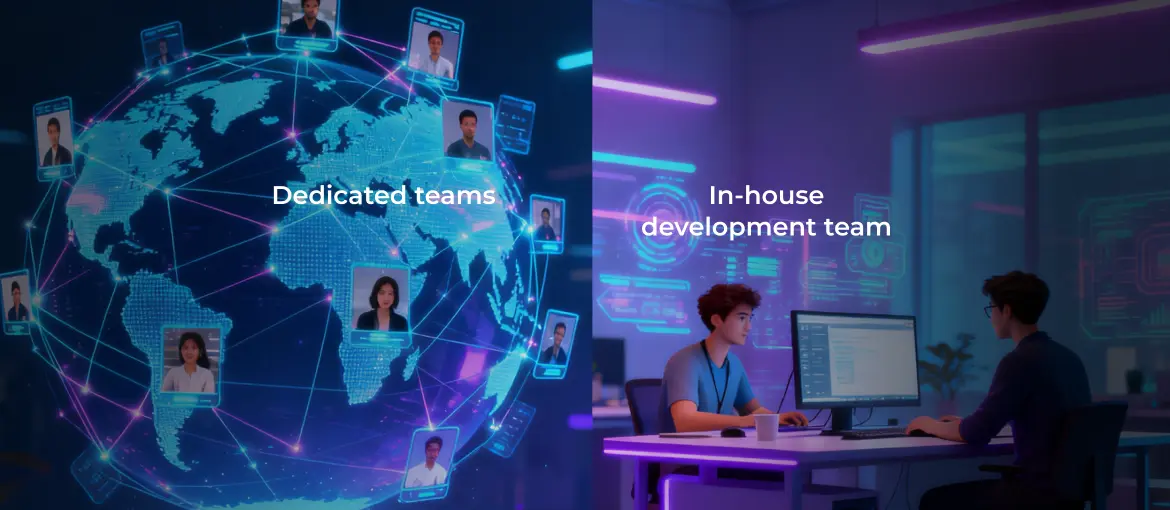It’s no coincidence that every FAANG brand and more than 170 Fortune Global 500 companies have set up offices in India. For enterprises looking to scale globally, the country represents a rare mix of abundant talent, competitive costs, and mature digital infrastructure. India has the world’s third-largest developer talent pool, containing over 12% of the global software engineering population. It’s also projected to be the only nation with a skilled talent surplus by 2030.
Cost efficiency is equally compelling: software developer rates in India are roughly 2.5–3.25 times lower than those of their U.S. peers. Combined with a thriving innovation ecosystem, these factors make India a top choice for enterprises expanding globally. Yet, while the opportunity is clear, companies that expand too quickly often discover that India’s business environment rewards strategic thinking and patience over speed.
The India paradox
India offers immense potential, but realizing that potential requires more than enthusiasm. Many global companies arrive drawn by the promise of scale and operational efficiency, only to discover that India’s business landscape can be challenging, especially if you don’t plan for the long term.
Beneath India’s advantages lies a web of regulatory complexity, regional diversity, and dynamic market conditions that demand a structured, system-level approach. Success here depends not only on speed but on understanding these local nuances and challenges from the perspective of finance, operations, and legal.
Let’s examine the five challenges that, in my experience, 90% of tech companies face when establishing local presence in India.
Challenge 1: Navigating India’s compliance landscape
India’s regulatory environment is among the most intricate of any major emerging market, with over 1,500 central and state-level labor, tax, and business regulations. For companies expanding here, compliance isn’t just a legal necessity — it’s a strategic capability that underpins long-term success.
Expanding into India means engaging with a fast-evolving legal system that touches nearly every business function — from data governance and cybersecurity to labor relations and sustainability. The most critical areas to address include:
- Data privacy: The Digital Personal Data Protection (DPDP) Act requires companies to obtain explicit user consent before collecting personal data, ensure robust data security, and report breaches immediately. Non-compliance can lead to fines of up to ₹250 crore (over $28,250) for a data breach and ₹200 crore for failing to report it.
- Cybersecurity: Under the Information Technology (IT) Act, companies must report cybersecurity incidents — including ransomware and phishing — to CERT-In within six hours of detection. Penalties for failure can include heavy fines or even jail time.
- Artificial intelligence (AI) governance: India is developing a national AI regulatory framework and has even established an AI Safety Institute to ensure responsible AI innovation. Current initiatives focus on algorithmic transparency, data bias, and accountability — signaling that AI governance has become a key compliance priority.
- Labor laws: Organizations must comply with all labor and employment laws, including those related to minimum wages, working hours, occupational safety, provident fund contributions, and health insurance. Enforcement is increasing, particularly in the tech and outsourcing sectors.
- Anti-corruption and financial regulations: Businesses must stay aligned with India’s anti-corruption laws and evolving Reserve Bank of India (RBI) regulations on anti-money laundering (AML) and countering the financing of terrorism (CTF). Transparent financial operations are essential to avoid reputational and legal risks.
- Environmental, social, and governance (ESG) compliance: The Securities and Exchange Board of India (SEBI) mandates ESG disclosures for specific companies, making sustainability reporting a growing priority. Firms are expected to track and disclose environmental impact, social initiatives, and governance standards with greater transparency.
- Corporate governance and fraud prevention: The Ministry of Corporate Affairs (MCA) has strengthened rules around internal controls, board oversight, and risk management frameworks. Companies are expected to demonstrate strong governance and proactive fraud prevention.
In short, India’s compliance scene rewards companies that invest early in local expertise, governance infrastructure, and continuous monitoring. Moving fast without these foundations often leads to rework, penalties, and reputational setbacks — turning what could have been a growth accelerator into an obstacle.
Challenge 2: Contractor model complexity and risks
India’s decades-long reputation as a global talent destination is well-earned — but it also comes with lessons. Even established multinationals like Accenture, Cognizant, and Amazon have faced legal repercussions for labor law violations, underscoring how complex India’s employment ecosystem can be. Today, as scrutiny around labor compliance intensifies, expanding companies must navigate these risks with precision.
Many new entrants rely on contractors and freelancers to achieve flexibility and cost efficiency. However, as these relationships evolve into long-term, full-time collaborations, companies risk contractor misclassification. This occurs when a worker operates under employee-like conditions — such as fixed hours, supervision, or company-provided equipment — while being labeled an independent contractor. Missteps of this kind can expose businesses to back taxes, benefit claims, and reputational damage.
To mitigate this risk, organizations often engage outsourcing and outstaffing vendors as well as Employer of Record (EOR) partners to balance agility with compliance. The most successful companies adopt a hybrid approach — blending flexible talent models with structured governance frameworks. Strong vendor partnerships, clear documentation, and consistent oversight enable companies to scale quickly while maintaining legal and operational integrity.
Challenge 3: Establishing and maintaining leadership amid growing diversity
Over the past decades, most of India’s 5.4 million technology professionals have clustered in seven major cities. But as companies reassess their operating models to balance cost, access to talent, and retention, Tier 2 cities are emerging as powerful alternatives.

| Tier 1 Cities | Tier 2 Cities |
| Examples: Mumbai, Delhi, Bangalore, Chennai, Pune, Hyderabad, Kolkata | Examples: Chandigarh, Jaipur, Ahmedabad, Indore, Nashik, Hubbali, Warangal, Mangaluru, Kochi, Coimbatore, Thiruvananthapuram, Tiruchirappalli, Madurai, Vellore, Vijayawada, Visakhapatnam, Nagpur, Bhubaneshwar, Raipur, Ranchi, Bhopal, Kanpur, Lucknow, Guwahati, Mysuru, Tirupati |
| Well-established infrastructure for tech business expansion | Home to 11–15% of India’s tech talent |
| Attract about 30% of graduates from non-metro cities relocating for employment | Produce 60% of India’s graduates from engineering, arts, and science programs |
| Mature ecosystems but higher costs | Offer up to 50% cost savings in real estate and allied services compared to Tier 1 cities |
(Source: Deloitte, “Emerging Technology Hubs of India”)
This ongoing shift creates a more diverse environment that calls for strong, clear local presence and leadership. In more practical terms, companies must establish accountability frameworks that empower local decision-making while maintaining alignment with global governance standards.
When local teams lack the authority to resolve operational or regulatory issues, execution slows, and confidence erodes. Practical enablers — such as delegated approval systems, embedded HR or finance partners, and direct escalation channels — ensure that local teams can act decisively and responsibly.
Ultimately, effective leadership in India means balancing structure and autonomy. Organizations that empower on-the-ground leadership to make timely, informed decisions not only move faster but also build the resilience required to scale sustainably.
Challenge 4: Hedging financial risks
When companies expand rapidly, finance is often treated as a supporting function. In reality, it’s foundational to sustainable growth. Currency fluctuations, inflation, and shifting market conditions can quietly erode margins and destabilize budgets if not managed proactively.
In India, these factors are particularly dynamic. According to Aon, the projected annual increase in software engineering and design salaries exceeds 10% in India, primarily driven by inflation, talent demand shifts, and global uncertainty. Coupled with FX volatility, this can shift cost projections by 8–10% annually. Without a structured financial framework, even well-established firms can find themselves exposed to sudden swings in payroll costs, vendor payments, or intercompany transfers.
Finance, in this context, is about more than accounting — it’s about timing and foresight. A thoughtful approach to risk mitigation, cost control, taxes, and currency management allows companies to turn uncertainty into an advantage. As one might say in tennis, winning isn’t just about power — it’s about timing. Finance gives you that timing.
Challenge 5: Setting the rhythm right
Scaling in India doesn’t happen in a single push — it unfolds in phases: registering entities, stabilizing operations, shaping culture, and then scaling teams. Each stage has its own rhythm, and the handoffs between stages are critical. Companies that rush often “drop the baton”: legal gets ahead of finance, HR moves forward without compliance alignment, and operational momentum stalls.
Companies that phase their expansion — from entity setup to operational stabilization — achieve significantly higher cost efficiency and encounter fewer compliance escalations. The key is pacing growth like a relay race, where carefully planned handoffs ensure smooth transitions. This approach allows legal, finance, HR, and operations to work in harmony, preventing bottlenecks.
Conclusion: Turning challenges into strategic advantages
Thriving in India requires strategic foresight, operational discipline, and local insight. From navigating complex compliance requirements and contractor models to establishing effective leadership, hedging financial risks, and pacing growth, each challenge is interconnected.
Companies that approach these areas proactively — building structured governance, empowering local teams, and leveraging expert guidance — don’t just mitigate risk; they turn potential obstacles into competitive advantages, creating a foundation for sustainable, scalable success.

If your expansion to India focuses on boosting your engineering and design capabilities, AgileEngine can help you move faster while handling the complexities of compliance, talent management, operations, and more. Recognized as a top professional destination in India, AgileEngine operates from Hyderabad and attracts top local talent.
On a larger scale, our footprint spans 15 countries across Asia, Europe, and Latin America, enabling high-efficiency, high-impact operations worldwide. Contact us to explore optimal collaboration strategies in India and beyond.












